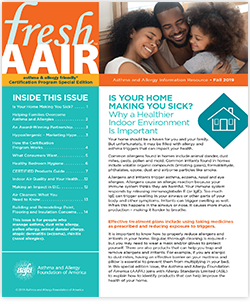October is Indoor Air Quality Awareness Month. Since your indoor air can be more polluted than outdoor air, this month is a good time to make sure you are taking the right steps to create healthier air in your home.
Your home should be a haven for you and your family. But unfortunately, it may be filled with allergy and asthma triggers that can impact your health.
Common allergens found in homes include animal dander, dust mites, pests, pollen and mold. Common irritants found in homes include volatile organic compounds (irritating gases), formaldehyde, phthalates, ozone, dust and airborne particles like smoke.
Allergens and irritants trigger asthma, eczema, nasal and eye allergies. Allergens cause an allergic reaction because your immune system thinks they are harmful. Your immune system responds by releasing immunoglobulin E (or IgE). Too much IgE can trigger swelling in your airways or other parts of your body and other symptoms. Irritants can trigger swelling as well. When this happens in the airways or nose, it causes more mucus production – making it harder to breathe.
Effective treatment plans include using taking medicines as prescribed and reducing exposure to triggers.
It is important to know how to properly reduce allergens and irritants in your home. Regular, thorough cleaning is required – but you may need to wear a mask and/or gloves to protect yourself. There are also products that can help you trap and remove allergens and irritants. For example, if you are allergic to dust mites, having an effective barrier on your mattress and pillow is essential to prevent them from multiplying in your bed.
You can also create healthier indoor air by:
- Vacuuming your floors with a CERTIFIED asthma & allergy friendly® vacuum cleaner weekly
- Replacing carpet with CERTIFIED solid surface flooring, if possible
- Running a fan in your bathroom at least 15 to 20 minutes after you shower
- Fixing leaks
- Removing scented candles, wax warmers and potpourri
- Not smoking or using a fireplace
- Using lids on trash cans
- Cleaning up food messes and dirty dishes quickly
- Using unscented and non-aerosol household cleaners
These are just a few ways you could improve the quality of your indoor air. The Asthma and Allergy Foundation of America (AAFA) joined with Allergy Standards Limited (ASL) to create the asthma & allergy friendly® Certification Program. We test household products against strict standards. If products pass our tests, they earn the CERTIFIED asthma & allergy friendly® mark. This program helps you make informed purchases for a healthier home.
 Sign up for our FREE asthma and allergy magazine – freshAAIR™! Get our latest issue full of information on ways you can create a healthier home and reduce exposure to asthma and allergy triggers. Read it online on your computer, tablet or mobile device.
Sign up for our FREE asthma and allergy magazine – freshAAIR™! Get our latest issue full of information on ways you can create a healthier home and reduce exposure to asthma and allergy triggers. Read it online on your computer, tablet or mobile device.

Comments (0)